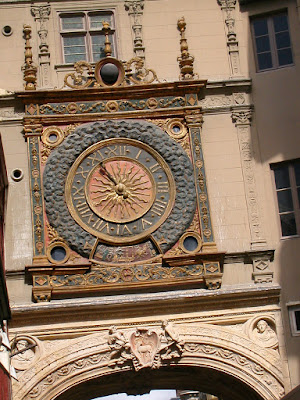
Clock with hour hand only, Rouen, France
When I'm trying to imagine the daily lives of my ancestors, there is a regularly occurring stumbling block. For lack of a better term, I'll call it "when-itis." As I begin to write about one of the wealthy farmers in the village proudly displaying his pendulum clock to impress my great-great grandfather, I'm suddenly wary. When was the pendulum clock invented? Would such a clock have been available for purchase in the 19th century? Nagged by doubts, I have two choices. I can spend awhile checking the Internet and reference books. Or I can write that the wealthy farmer showed my great-great grandfather his new ox.
An article in "Der Blumenbaum," the quarterly magazine of the Sacramento (California) German Genealogical Society was a happy find. It gave a timeline, going back to the first century AD, of important events, including many inventions. This list will eliminate a few guesses for me. I will be able to use that pendulum clock idea after all.
1284, the first wearable eyeglasses were invented in Italy.
1300's, the first mechanical clocks appeared, like the massive one-handed clock which still tells the hour in Rouen in Normandy.
1400's, playing cards became popular in Europe.
1500's, Latin began to decline as the language of books, in favor of the vernacular. The German practice of decorating Christmas trees was well established.
1565, the potato, which originated in the Americas, was introduced to Europe.
1580's, pockets in trousers were introduced.
1600's, toothbrushes were becoming common in Europe.
1608, the telescope was developed.
1632, the slide rule was invented
1639, what is thought to have been the first Christkindlmarkt took place in Nürnberg
1656, the pendulum clock was invented.
1660's, the first regularly published newspapers appeared in Germany and England.
1670, clocks with second hands were developed.
1709, the pianoforte was invented.
1760, the first jigsaw puzzle was created.
1783, hot air balloons appeared and this led to the first manned flight.
1791, a process for producing cheap soap was invented.
1800's, there was a widespread use of pocket watches and more general concern for punctuality.
1800's, multi-tined forks were becoming common.
1802, an improved strain of sugar beets was used to produce sugar for the first time.
1805, self-igniting matches were invented (but were extremely dangerous until friction matches were developed in 1827)
1806, gas lighting was introduced in European cities; and carbon paper was invented.
1817, in German, Karl von Drais invented the Laufmaschine, a forerunner to the bicycle.
1820, cloth began replacing leather for book casings.
1829, the first reliable locomotive was developed, marking the beginning of commercial railroads.
1835, the first German railroad ran from Nürnberg to Fürth, approximately four miles.
1840's, brass bands became popular in Germany.
1843, a London artist printed the first Christmas cards.
1849, the safety pin was patented.
1850, telegraphic cable connection was laid across the English Channel.
And last but certainly not least (for someone who can't imagine life without them) potato chips were created in Saratoga Springs, New York in 1853.
SOURCE: "A Timeline for Americans of German Descent," DER BLUMENBAUM, Vol. 24, No. 3, pp. 130-136